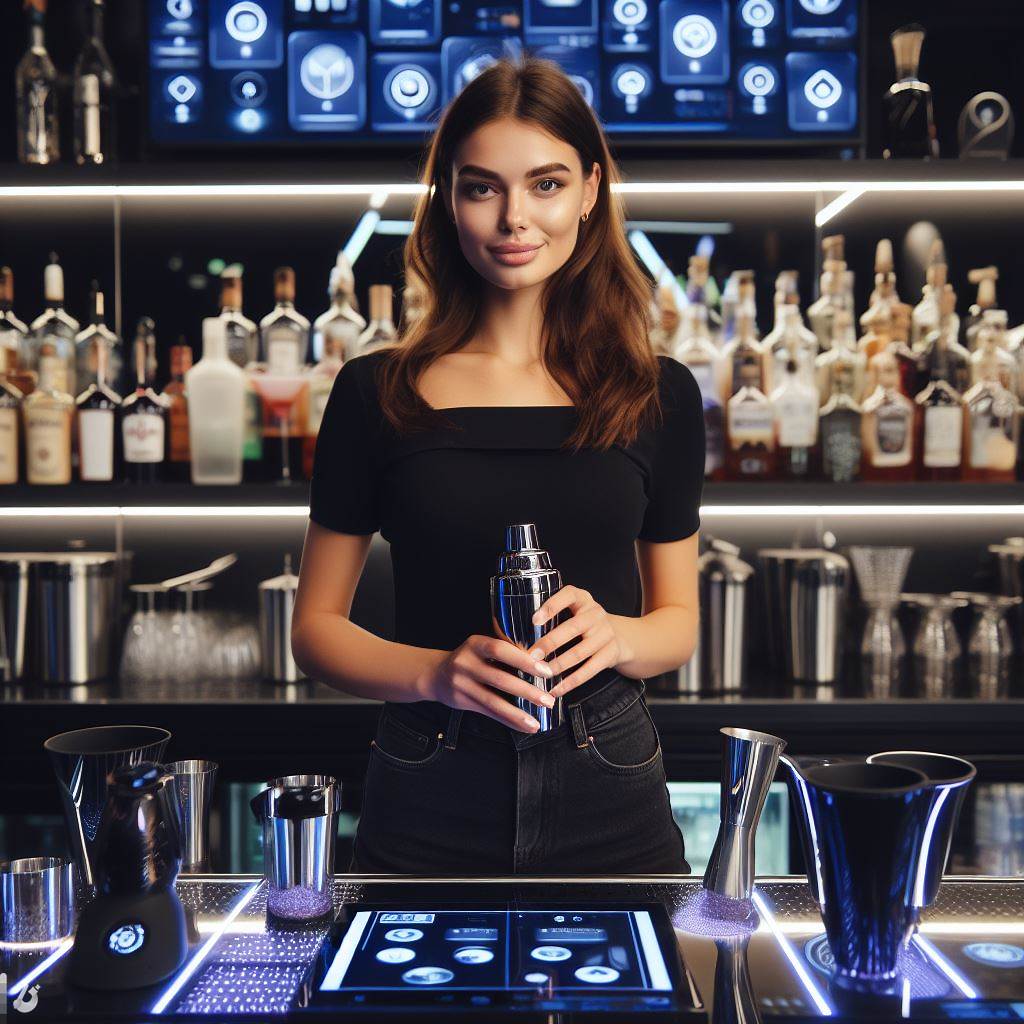Introduction
Bartending in the United States is undergoing a transformative shift as technology takes center stage.
Amid the clinking glasses and laughter, a new era emerges, seamlessly blending tradition with innovation.
Bars across the country are fervently adopting technological advancements, reshaping the customer experience and operational dynamics.
In this blog section, we unravel the symbiotic relationship between bartending and technology.
Picture interactive touchscreen tables amplifying engagement, mobile apps revolutionizing order placements, and state-of-the-art POS systems optimizing transactions.
The landscape is evolving, and with it, the very essence of the bar experience.
Join us as we explore this captivating journey where the allure of mixology meets the precision of technology.
From the pulsating energy of urban hotspots to the cozy charm of local pubs, the future of bartending in the United States is unfolding before our eyes.
Embrace the revolution, where innovation is the elixir, and tradition is the timeless chaser.
History of Bartending
Origins and Evolution of Bartending
Bartending has a long and fascinating history that dates back thousands of years.
The roots of bartending can be traced back to ancient civilizations such as Mesopotamia, Egypt, and Greece.
In these cultures, taverns and alehouses were popular gathering places where people would gather to socialize and enjoy alcoholic beverages.
However, it wasn’t until the Middle Ages that bartending began to take on a more recognizable form.
During this time, bartenders were typically referred to as “tavern keepers” and their main responsibility was to serve and sell drinks to patrons.
The concept of mixology, or the art of mixing drinks, also emerged during this period.
As time went on, bartending continued to evolve.
The Industrial Revolution brought about significant changes in society, including advances in technology and transportation.
This led to the growth of cities and the rise of the modern bar.
Bartenders began to experiment with different ingredients and techniques, creating new and innovative cocktails.
The Traditional Approach to Bartending
For many years, bartending was often seen as a job that required little skill or expertise.
Transform Your Career Today
Unlock a personalized career strategy that drives real results. Get tailored advice and a roadmap designed just for you.
Start NowBartenders were expected to simply pour drinks and serve customers, without much emphasis on creativity or knowledge of the craft.
This traditional approach to bartending focused more on efficiency and speed rather than quality or customer experience.
In this traditional approach, bartenders were often limited to a set menu of classic cocktails and standard drink recipes.
The main goal was to serve as many customers as possible in a short amount of time.
This approach worked well for many establishments, especially those focused on volume and high turnover.
However, over time, attitudes towards bartending began to change.
With the rise of the craft cocktail movement, customers started to demand more from their bartenders.
They wanted unique and innovative drinks, as well as a personalized experience.
This shift in mindset has led to a renaissance in the bartending industry.
Bartenders are now viewed as skilled artisans, creating carefully crafted cocktails using fresh and high-quality ingredients.
They have also become experts in their field, with extensive knowledge of spirits, flavor profiles, and mixology techniques.
Therefore, the history of bartending is rich and diverse, with its origins dating back centuries.
From its humble beginnings in ancient cultures to the modern craft cocktail movement, bartending has come a long way.
Today, bartenders are not only skilled professionals but also ambassadors of the craft, using their creativity and expertise to elevate the bar experience for customers.
Read: Job Opportunities for Bartenders: Beyond the Traditional Bar
Technology in the Bar Industry
Explain the emergence of technology in the bar industry
The bar industry has witnessed the emergence of technology in recent years, revolutionizing how bars operate.
Technology has become an integral part of the bar industry, improving efficiency and customer experience.
The benefits of integrating technology in bars
Increased efficiency in operations and customer service
By integrating technology, bars can streamline their operations, resulting in faster and more efficient service to customers.
Enhanced inventory and ordering systems
Technology allows bars to track inventory in real-time, minimizing wastage and ensuring that popular items are always in stock.
Showcase Your Business Today
Reach thousands of readers actively exploring professional services. Publish your business profile and grow your audience now.
Publish NowImproved customer experience and engagement
With technology, bars can offer personalized experiences, such as customized drink recommendations and interactive entertainment options.
The various types of technology used in bars
POS systems
Point-of-sale (POS) systems are essential for managing transactions, tracking sales, and generating reports for better decision-making.
Self-service kiosks
Self-service kiosks allow customers to place their orders directly, eliminating the need for waiting staff and reducing wait times.
Mobile ordering and payment apps
Mobile apps enable customers to order and pay for their drinks directly from their smartphones, providing convenience and flexibility.
Automated dispensing systems
Automated dispensing systems accurately measure and pour drinks, ensuring consistency in taste and reducing the risk of over-pouring.
Digital menu displays
Digital menu displays replace traditional paper menus, allowing bars to easily update offerings and showcase visuals to attract customers.
Embracing technology has become crucial for bars looking to stay competitive in the modern market.
By integrating technology, bars can enhance their operations, offer personalized experiences, and provide efficient service.
The bar industry is evolving, and technology is shaping the future of this traditional business.
Read: Certifications to Boost Your CSR Career in the USA

Case Studies: Examples of US Bars Embracing Technology
A number of bars in the United States have successfully incorporated technology into their operations, resulting in various benefits for both the establishments and their customers.
Here are a few noteworthy examples:
The Spare Room in Los Angeles, California: Implementation and Impact of Technology
- The Spare Room in Los Angeles, California has fully embraced technology by implementing a digital ordering system.
- The introduction of tablet-based menus and ordering has streamlined the entire process.
- Customers can now browse the menu, place orders, and pay for their drinks directly through the tablets.
- This has significantly reduced wait times, enhancing overall customer satisfaction.
- In addition, The Spare Room in Los Angeles, California has implemented a smart inventory management system.
- The system automatically tracks inventory levels and generates alerts for restocking.
- By minimizing manual inventory checks, The Spare Room in Los Angeles, California has achieved cost savings and improved efficiency.
The Barbershop Cuts & Cocktails in New York, New York: Transformation and Customer Response
- The Barbershop Cuts & Cocktails in New York, New York underwent a complete digital transformation by introducing interactive bartending stations.
- Customers can now customize their drinks using touchscreen panels at the bar.
- The innovation has not only enhanced the customer experience but also increased customer engagement.
- The Barbershop Cuts & Cocktails in New York, New York has witnessed a surge in social media mentions and positive reviews across various platforms.
- The bartending stations have become a major attraction, drawing new customers to the bar.
- Regular customers have also embraced the technology, appreciating the unique and personalized experience.
The Barbershop Cuts & Cocktails in New York, New York: Innovative Use of Technology for Mixology
- The Barbershop Cuts & Cocktails in New York, New York is renowned for its innovative use of technology in mixology.
- They have introduced robotic bartenders that can create complex cocktails with precision.
- The robots are programmed to replicate the exact measurements and techniques of expert mixologists.
- Customers are fascinated by the mesmerizing movements of the robotic bartenders.
- The technology not only adds an element of excitement but also ensures consistency in drink quality.
- The Barbershop Cuts & Cocktails in New York, New York has gained a reputation as a pioneer in mixology, attracting enthusiasts and curious patrons.
These case studies demonstrate how US bars have successfully leveraged technology to revolutionize their operations.
Whether it’s through digital ordering systems, interactive bartending stations, or robotic mixologists, the integration of technology has had a significant impact on customer experience, operational efficiency, and overall business success.
Read: Bartending Post-Covid: Changes and Adaptations in the US
Challenges and Concerns
Potential Challenges in Embracing Technology
- Initial setup costs and investment: Purchasing and implementing new technology can be expensive and require a significant investment.
- Training staff to use new technology: Employees may require extensive training to fully utilize and understand the new technology.
- Ensuring data security and privacy: Implementing technology introduces potential risks for data breaches and privacy concerns.
Addressing Concerns of Potential Dehumanization of the Bar Experience
While embracing technology offers numerous benefits, there are concerns about the potential dehumanization of the bar experience due to its implementation.
The rise of technology in bars may lead to a decrease in human interaction and personalized service.
Traditional bartending involves face-to-face interactions, creating connections, and tailoring drinks to individual preferences.
With technology taking over some of these tasks, there is a fear that the bar experience will become less personal and more transactional.
However, there are ways to address these concerns and ensure that technology enhances rather than replaces human interaction:
Balancing technology and human touch
Bar owners should strive to strike a balance between utilizing technology and maintaining a personal touch.
Technology should be seen as a tool to enhance efficiency and customer experiences rather than completely replacing the human element.
Empowering staff
Training staff to effectively use new technology can help bridge the gap between human interaction and the use of digital tools.
When employees are comfortable with technology, they can focus more on engaging with customers and providing exceptional service.
Leveraging technology for data-driven personalization
Instead of replacing human interaction, technology can be used to enhance personalization.
Bar owners can leverage data collected through technology to understand customers’ preferences and create tailored experiences that cater to their individual tastes.
Customizing technology to fit the brand
Generic technology solutions may contribute to the dehumanization of the bar experience.
Bar owners should seek customizable technology options that align with their brand’s personality and values, ensuring that the technology complements rather than detracts from the overall atmosphere.
Offering unique experiences
Bars can differentiate themselves by providing unique experiences that technology cannot replicate.
Live performances, themed nights, or interactive activities can create a sense of excitement and engagement that complements the use of technology.
Basically, embracing technology in the bar industry comes with its own set of challenges and concerns.
Addressing hurdles and prioritizing the human aspect enhances customer experiences, improves operational efficiency, and integrates technology effectively.
Read: Networking for Bartenders: US Bars and Bartender Associations
Future Trends in Bartending and Technology
Predict future advancements in bar technology
- Bar technology will continue to evolve to enhance efficiency and improve customer experiences.
- Smart tap systems will become more prevalent, allowing bartenders to monitor keg levels and track sales.
- Self-pouring systems will gain popularity, enabling customers to dispense their preferred drinks with minimal assistance.
- Cashless payment systems will become the norm, making transactions quicker and more convenient.
- Robotic bartenders will be developed further to handle basic drink mixing and repetitive tasks.
The integration of AI and automation in bars
- AI-powered chatbots will assist customers in placing orders, answering questions, and offering personalized recommendations.
- Automated inventory management systems will track stock levels, predict demand, and streamline the ordering process.
- AI algorithms will analyze customer preferences and behavior, allowing bars to suggest tailored drink options and promotions.
- Facial recognition technology will be used for age verification and creating personalized customer experiences.
- AI-driven customer service platforms will handle customer feedback and resolve issues in real-time.
The potential impact of augmented reality (AR) and virtual reality (VR) on the bar industry
- AR menus will provide immersive visuals and interactive experiences, showcasing drink ingredients and mixing techniques.
- VR-enabled virtual bars will allow customers to visit distant or fictional locations while enjoying their favorite drinks.
- AR glasses will enhance the ambiance by projecting virtual elements such as live performances or themed decorations.
- Virtual tasting experiences will enable customers to explore various drink flavors and combinations without physical limitations.
- AR and VR technologies will encourage social interactions as customers can connect with friends in virtual bar environments.
In review, the future of bartending will be shaped by advancements in technology.
Bars will incorporate smart tap systems, self-pouring systems, cashless payment systems, and robotic bartenders to improve efficiency and customer experiences.
AI and automation will play a significant role in chatbots, inventory management, customer analysis, and facial recognition.
Augmented reality (AR) and virtual reality (VR) will offer immersive experiences through AR menus, VR-enabled virtual bars, AR glasses, and virtual tasting experiences.
Embracing these future trends will undoubtedly revolutionize the bar industry.
Conclusion
A recap of the main points discussed in the blog post
- The introduction of technology in bars has revolutionized the industry.
- Bar owners are embracing new tech solutions to enhance customer experience.
- Tableside ordering systems and cocktail-making robots are becoming more prevalent.
- Technology has streamlined operations, reduced errors, and increased efficiency in bars.
- Online platforms have made it easier for customers to discover bars and explore their offerings.
Emphasizing the importance of technology in modernizing the bar industry
The integration of technology has not only improved operations but also transformed the way bars connect with customers.
Encouraging readers to explore the role of technology in their local bars
Next time you visit a bar, take a moment to observe the technological advancements they have implemented.
Showcase Your Business Today
Reach thousands of readers actively exploring professional services. Publish your business profile and grow your audience now.
Publish NowEnd with a thought-provoking closing statement or call to action
As technology continues to evolve, the bar industry needs to adapt to stay at the forefront of innovation.
Cheers to a tech-savvy future!
[E-Books for Sale]
The Big Book of 500 High-Paying Jobs in America: Unlock Your Earning Potential
$19.99 • 500 High-Paying Jobs • 330 pages
Explore 500 high-paying jobs in America and learn how to boost your career, earn more, and achieve success!
See All 500 High-Paying Jobs of this E-Book
1001 Professions Without a Degree: High-Paying American Jobs You Can Start Now
$19.99 • 1001 Professions Without a Degree • 174 pages
Discover 1001 high-paying jobs without a degree! Unlock career tips, skills, and success strategies for just $19.99!




